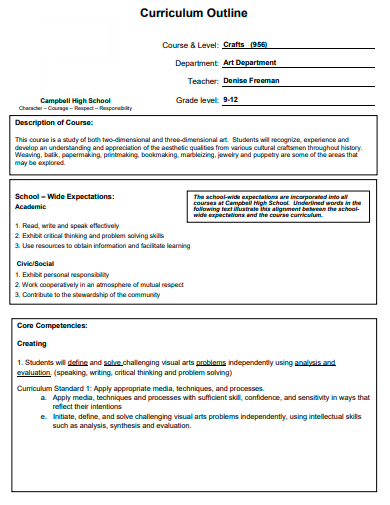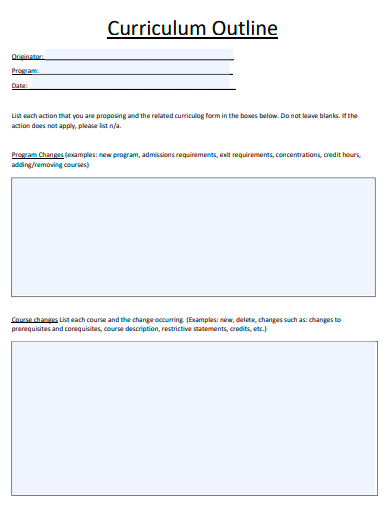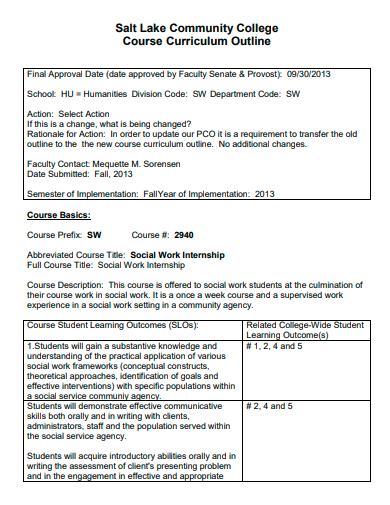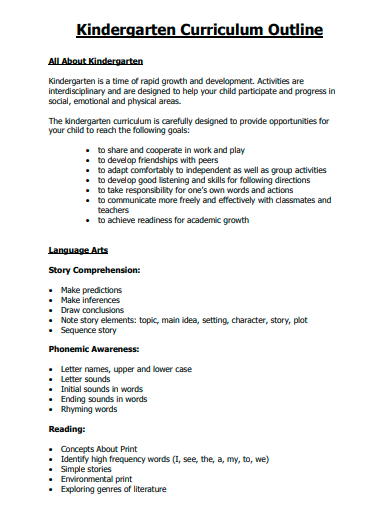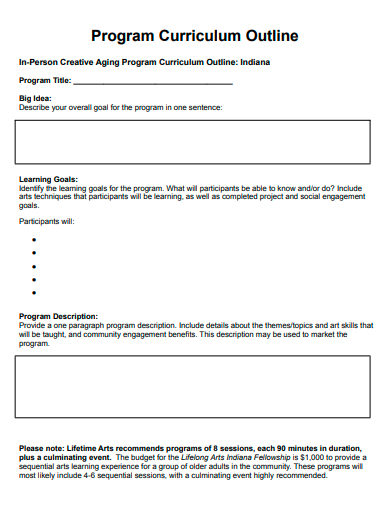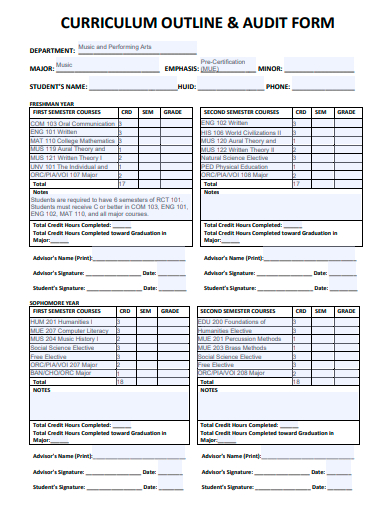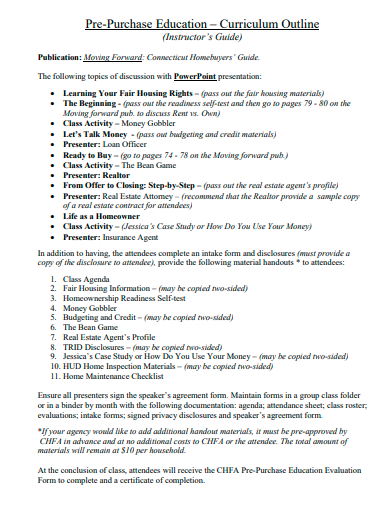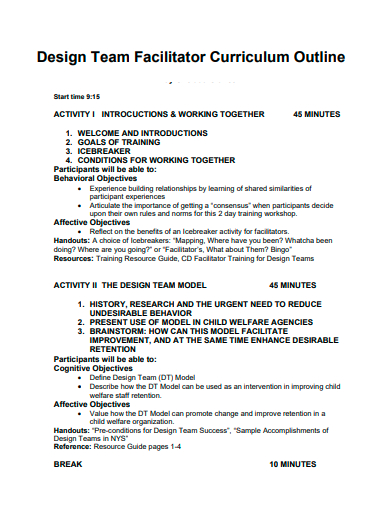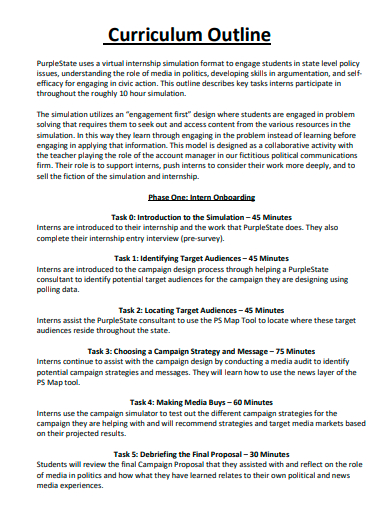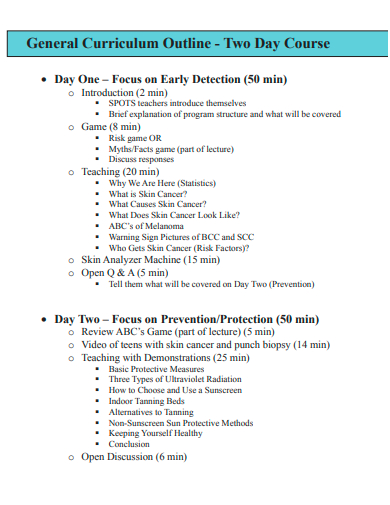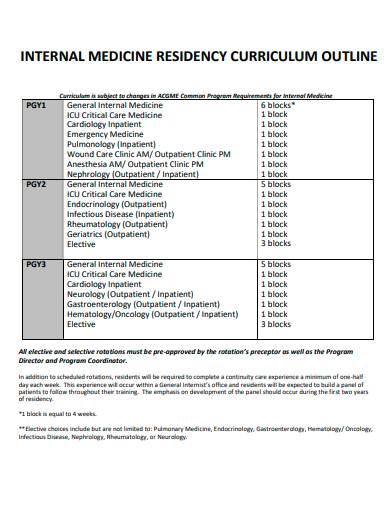A curriculum is a set of activities and learning outcomes or goals related to a subject taught in schools. It serves as an outline that maps out the direction of your lesson plan and how to achieve it. With a curriculum outline, you can ensure that you are progressing on the right track while allowing you to develop teaching concepts, ranging from basic levels to more complex skills or topics. It sets goals for both professors and students, which allows teachers to align their teaching methods with their student’s academic requirements.
FREE 10+ Curriculum Outline Samples
1. Curriculum Outline Template
2. Basic Curriculum Outline
3. Course Curriculum Outline
4. Kindergarten Curriculum Outline
5. Program Curriculum Outline
6. Curriculum Outline and Audit Form
7. Pre-Purchase Education Curriculum Outline
8. Design Team Facilitator Curriculum Outline
9. Curriculum Outline in PDF
10. General Curriculum Outline
11. Internal Medicine Residency Curriculum Outline
What is a Curriculum Outline?
A course plan or curriculum outline is a part of course design that summarizes course plans as well as keeps a record of the curriculum at a course level and supports learning processes by determining the appropriate learning requirements, evaluation processes, learning activities, and learning resources. With a curriculum outline, you can have a broad overview of an entire program across various grade levels. This document also contains the course description, schedule, assessment tasks, due dates, and more.
How to Create a Curriculum Outline?
A curriculum outline is a resource that enables both teachers and students to better understand their course by defining its aims and learning objectives, requirements, textbook, and assessment criteria and dates. This outline is used to determine the most effective approach to teaching and learning and design a plan on how to use learning materials to help students perform a series of tasks or activities as well as for the professional development of work colleagues.
Step 1: Determine your Content
Start by ensuring that you have a clear understanding of the content, material, and objectives of your curriculum. By doing so, it will be easier for you to plan the overall intention of your course or curriculum. Explore more to determine whether you need to use a course outline template or you can design your own strategic plan.
Step 2: Learn About your Learners
Learning about your students’ identities when outlining your curriculum will enable you to identify the learning materials that can best support their learning outcomes, organize your ideas, and choose the appropriate materials and activities. Some of these identities include the students’ age, demographics, and the courses they are enrolled in.
Step 3: Collect Learning Materials and Tasks
Think of ideas for learning materials and activities that can help your students in meeting their personal goals or academic career goals based on their learning outcomes. Consider your timeline and arrange your learning materials into manageable sections or units.
Step 4: Plan your Assessment Analysis
With an assessment analysis, you will determine an effective method to help students in establishing their prior knowledge and determine areas they need to review or focus more on. This analysis can be casual and formative or formal and summative. This also enables students to reflect on their own learning and understanding of the lessons they have taken.
FAQs
What are the common elements in a course outline?
A course outline usually contains elements such as the learning objectives and goals, sections or learning activities, supporting materials, assessments like assignments, reflection papers, quizzes, exams, and other student papers, and learning milestones.
What type of content can be included in a curriculum outline?
Some of the types of content that can be covered in a curriculum outline include administrative information, required texts, materials, and readings, course descriptions, the intended learning outcomes, sequence of class activities, grading procedures, other course policies and procedures, and any institution-required statements.
What are the advantages of using a curriculum outline?
With a curriculum outline, you can establish a roadmap you can take to accomplish your goal, a timeline you can follow, and the methods you can follow to realize your goals. It also provides you with visibility of your progress. This outline also enables educators to align their learning materials to the learning requirements of their students, ensuring the effectiveness of their lessons.
A course or curriculum outline is a tool used by both teachers and students to design a course plan to achieve their learning goals by ensuring that they are taking the correct path and methods. This document enables teachers to determine the learning materials they need for the educational development of their students and enables students to establish their goals and design a roadmap to achieve them.
Related Posts
FREE 10+ Training Meeting Minutes Samples [ Committee, Course ...
FREE 10+ Course Project Proposal Samples [Training, Education ...
FREE How to Develop a Sales Training Plans [ With Samples ]
FREE 10+ Attendance Policy Samples in PDF MS Word | Pages ...
FREE 10+ Elementary Library Lesson Plan Samples in MS Word ...
FREE 10+ Lesson Plan Outline Samples in MS Word PDF
FREE 10+ Academic Course Proposal Samples in PDF DOC
FREE 7+ Medical Student CV Samples in MS Word PDF
FREE 14+ Sample Bat Templates in MS Word PDF
FREE 10+ Employment History Templates in MS Word PDF
FREE 10+ School Training Plan Samples in MS Word Google Docs ...
FREE 10+ Librarian Lesson Plan Samples in MS Word Pages ...
FREE 10+ Training Roadmap Samples in MS Word Google Docs ...
FREE 8+ Sample Academic CV Templates in PDF MS Word
FREE 7+ Sample Seminar Planning Templates in PDF MS Word

